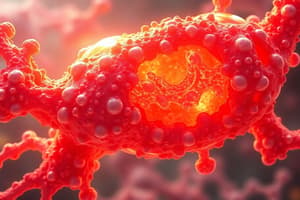Podcast
Questions and Answers
المستكة تستخدم فقط في المنتجات الحلوة مثل الآيس كريم والمعجنات.
المستكة تستخدم فقط في المنتجات الحلوة مثل الآيس كريم والمعجنات.
False (B)
تعتبر المستكة عنصرًا شائعًا في الأطعمة والمشروبات.
تعتبر المستكة عنصرًا شائعًا في الأطعمة والمشروبات.
True (A)
يمكن استخدام المستكة فقط في الحلويات.
يمكن استخدام المستكة فقط في الحلويات.
False (B)
تستخدم المستكة في المشروبات الغازية فقط.
تستخدم المستكة في المشروبات الغازية فقط.
المستكة لا تحتوي على استخدامات طبية.
المستكة لا تحتوي على استخدامات طبية.
مذاق الزع أو القابض الذي نشعر به عند تناول الفواكه غير الناضجة هو نتيجة وجود مركبات الكحول.
مذاق الزع أو القابض الذي نشعر به عند تناول الفواكه غير الناضجة هو نتيجة وجود مركبات الكحول.
يعلق التانيين بالبروتينات الموجودة في اللعاب.
يعلق التانيين بالبروتينات الموجودة في اللعاب.
التوت الأسود يعتبر فاكهة ناضجة دائماً.
التوت الأسود يعتبر فاكهة ناضجة دائماً.
الزع هو طعم يمكن أن يشعر به الشخص عندما يأكل فواكه ناضجة فقط.
الزع هو طعم يمكن أن يشعر به الشخص عندما يأكل فواكه ناضجة فقط.
تناول الفواكه غير الناضجة لا يمكن أن ينتج عنه تأثير الزع.
تناول الفواكه غير الناضجة لا يمكن أن ينتج عنه تأثير الزع.
النكتارية الهيكلية يمكن أن تكون في شكل شعيرات جلدية وحيدة الخلية غير غددية.
النكتارية الهيكلية يمكن أن تكون في شكل شعيرات جلدية وحيدة الخلية غير غددية.
توجد النكتاريات الهيكلية فقط في شكل هياكل غدية.
توجد النكتاريات الهيكلية فقط في شكل هياكل غدية.
جميع أنواع النكتاريات الهيكلية تعتمد على الغدد للقيام بوظائفها.
جميع أنواع النكتاريات الهيكلية تعتمد على الغدد للقيام بوظائفها.
النكتارية الهيكلية قد تتواجد في شكل شعيرات غير غدية.
النكتارية الهيكلية قد تتواجد في شكل شعيرات غير غدية.
يعتمد شكل النكتارية الهيكلية فقط على ما إذا كانت غدية أم لا.
يعتمد شكل النكتارية الهيكلية فقط على ما إذا كانت غدية أم لا.
الميرستيم النامي (مثل البراعم القشرية) ليس مغطى بالكامل بمخلفات كولتر.
الميرستيم النامي (مثل البراعم القشرية) ليس مغطى بالكامل بمخلفات كولتر.
الشعيرات اللاسعة في نبات الأورتيكا لها قاعدة غدية تشبه المثانة.
الشعيرات اللاسعة في نبات الأورتيكا لها قاعدة غدية تشبه المثانة.
الشعيرات الغدية هي هياكل سريرية متعددة الخلايا، إما عالقة أو ذات ساق.
الشعيرات الغدية هي هياكل سريرية متعددة الخلايا، إما عالقة أو ذات ساق.
تتكون الشعيرات الغدية ذات الساق من ساق سري وخلايا غير سريرية.
تتكون الشعيرات الغدية ذات الساق من ساق سري وخلايا غير سريرية.
البراعم القشرية تعتبر نوعًا من أنواع الميرستيم النامي.
البراعم القشرية تعتبر نوعًا من أنواع الميرستيم النامي.
الجزء العلوي من الشعيرات اللاسعة في الأورتيكا يكون على شكل شكل قضيبي.
الجزء العلوي من الشعيرات اللاسعة في الأورتيكا يكون على شكل شكل قضيبي.
يمكن أن تكون الشعيرات الغدية إما ذات ساق أو غير ذات ساق.
يمكن أن تكون الشعيرات الغدية إما ذات ساق أو غير ذات ساق.
الشعيرات الغدية هي هياكل تعمل على تخزين العناصر الغذائية في النباتات.
الشعيرات الغدية هي هياكل تعمل على تخزين العناصر الغذائية في النباتات.
تمتلك البراعم القشرية خصائص تشبه الجذور.
تمتلك البراعم القشرية خصائص تشبه الجذور.
تتكون الرأس السريري في الشعيرات الغدية من خلايا متعددة.
تتكون الرأس السريري في الشعيرات الغدية من خلايا متعددة.
الجزء القاعدي للجسم يحتوي على خلايا جلدية منخفضة.
الجزء القاعدي للجسم يحتوي على خلايا جلدية منخفضة.
الجزء المدبب للجسم يحتوي على جدران مشبعة بالسليكا.
الجزء المدبب للجسم يحتوي على جدران مشبعة بالسليكا.
الجدار الأساسي للجسم مشبع بالكالسيوم.
الجدار الأساسي للجسم مشبع بالكالسيوم.
الخلايا الجلدية في الجزء المدبب هي الأقل ارتفاعاً في الجسم.
الخلايا الجلدية في الجزء المدبب هي الأقل ارتفاعاً في الجسم.
يتمتع الجزء المدبب بجدران مشبعة بالكالسيوم.
يتمتع الجزء المدبب بجدران مشبعة بالكالسيوم.
Flashcards
التوت الأسود
التوت الأسود
نوع من الفاكهة يُعرف باسم التوت الأسود.
الزع
الزع
شعور حامض أو قاسٍ في الفم عند تناول الفاكهة غير الناضجة.
الظّالعات
الظّالعات
مادة موجودة في الفواكه غير الناضجة تُسبب الشعور بالزع.
البروتينات
البروتينات
Signup and view all the flashcards
الظّالعات و البروتينات
الظّالعات و البروتينات
Signup and view all the flashcards
استخدامات الماستيك
استخدامات الماستيك
Signup and view all the flashcards
آيس كريم
آيس كريم
Signup and view all the flashcards
حلويات
حلويات
Signup and view all the flashcards
المعجنات
المعجنات
Signup and view all the flashcards
الاستخدامات الغذائية
الاستخدامات الغذائية
Signup and view all the flashcards
أشكال الغدد الهيكلية
أشكال الغدد الهيكلية
Signup and view all the flashcards
الغدد الهيكلية
الغدد الهيكلية
Signup and view all the flashcards
الألياف الغير غدية
الألياف الغير غدية
Signup and view all the flashcards
الهياكل الغدية
الهياكل الغدية
Signup and view all the flashcards
البشرة
البشرة
Signup and view all the flashcards
الغدد الطاردة
الغدد الطاردة
Signup and view all the flashcards
التريخومات الإفرازية ذات الساق
التريخومات الإفرازية ذات الساق
Signup and view all the flashcards
الهياكل الطاردة
الهياكل الطاردة
Signup and view all the flashcards
الخلايا الطاردة
الخلايا الطاردة
Signup and view all the flashcards
التريخومات
التريخومات
Signup and view all the flashcards
براعم مُتغطية
براعم مُتغطية
Signup and view all the flashcards
شعر حارق
شعر حارق
Signup and view all the flashcards
إفرازات خاصة
إفرازات خاصة
Signup and view all the flashcards
براعم النمو
براعم النمو
Signup and view all the flashcards
قاعدة شعر حارق
قاعدة شعر حارق
Signup and view all the flashcards
خلايا البشرة المرتفعة
خلايا البشرة المرتفعة
Signup and view all the flashcards
سيليكا
سيليكا
Signup and view all the flashcards
الكالسيوم
الكالسيوم
Signup and view all the flashcards
الجدار الخارجي (الجزء الشبيه بالإبر)
الجدار الخارجي (الجزء الشبيه بالإبر)
Signup and view all the flashcards
الجدار الخارجي (القاعدة)
الجدار الخارجي (القاعدة)
Signup and view all the flashcards
Study Notes
Secretory Structures
- Plant secretory structures are involved in secreting essential oils, tannins, terpenes, mucilage, latex, resins, water, salts, enzymes, and hormones. These substances can be metabolic byproducts or have specific physiological functions.
- Secretory structures can be internal or external.
Internal Secretory Structures
-
Secretory Cells (Idioblasts):
- These are single cells that are distinct from non-secretory cells.
- They can contain various substances.
- Examples include oil cells in Gossypium (cotton), mucilaginous idioplasts in Malvaceae, and tanniferous idioblastrs which contain tannins (phenol derivatives). Tannins are used in dyeing and ink preparation.
- Tannins are found in blackberries, cranberries, tea, nuts, grapes, apples, and legumes. They give an astringent taste to unripe fruit by binding to proteins in saliva.
-
Secretory Cavities and Ducts:
- Formed by cell disintegration (lysigenous cavities) or by the separation of cell walls (schizogenous cavities).
- Cavities are typically spherical, while ducts are elongated.
- Can contain resins, oils, or gums.
- Citrus oil cavities are an example of a secretory cavity.
- Resin ducts are common in conifers and develop in vascular and ground tissues.
- Gummosis: The transformation of substances like starch into amorphous gum.
3-Laticifers
- Laticifers are secretory systems that produce latex. Latex can be colorless, white, yellow, yellow-orange, yellow-brown, or red.
- Natural rubber latex constitutes 50% of total rubber production, the other 50% is synthetic.
- Latex from Papaver somniferum (opium poppy) contains important alkaloids like morphine, codeine, and papaverine.
Types of Laticifers
- Non-articulate (laticiferous cells): Develop from single cells that elongate with the growth of the plant.
- Articulate (laticiferous vessels): Develop from series of cells. Cells may be branched or unbranched; end walls may remain entire or become porous, or disappear entirely.
External Secretory Structures
- Hydathodes: Water stomata or special structures on leaves and the apex and margin where liquid exudates (water droplets).
- Nectaries (nectar-secreting trichomes):
- Nectar is a sugary solution.
- Can be structural or non-structural.
- Structural nectaries have specialized tissue structure distinct from surrounding epidermal tissue, often with high portion of phloem.
- Locations: can develop on all parts of the plant, particularly floral parts.
3-Glandular Epidermal Trichomes
- Secrete essential oils, which are potential sources of natural fragrances and have use in pharmaceuticals.
- Can be sessile (stalkless) or stalked.
- Stalked trichomes have a non-secretory stalk and secretory head (unicellular or multicellular).
A-Salt Secreting Trichomes
- Located in halophytic species (e.g., Avicennia).
- Consist of collecting cells, stalk cells, and secretory cells.
- Excrete salt solution through pores in the cuticle to regulate internal salt load.
B- Mucilage-secreting trichomes
- Produce sticky mucilage.
- Found on plants like Drosera (carnivorous plants) to capture insects.
C- Collators
- Multicellular secretory structures on apices.
- Protect developing meristems (e.g. stems, nascent buds) by producing viscous, sticky secretions that are mainly comprised of terpenes and mucilage.
D- Stinging trichomes
- Common on nettle plants ( Urtica).
- Needle-like, upper part and bladder-like base.
- Base is embedded in epidermal cells and internally has a siliceous lining that enhances structural integrity.
- The pointed trichomes penetrate skin, release histamine and acetylcholine causing irritation.
E- Terpene-secreting trichomes
- Produce essential volatile oils, which are often irritating to insects.
- Common in Solanum lycopersicum (tomatoes).
- Essential oils, frequently in the form of insecticidal carboxylic acid derivatives, in some plants.
- Secrete volatile oils, such as p-menthanes (e.g., Mentha)
D- Osmophors
- Scent glands in flowers.
- Secrete volatile essential oils that produce flower scents.
- Oils diffuse through cell walls, cytoplasm, and cuticle to the atmosphere.
Studying That Suits You
Use AI to generate personalized quizzes and flashcards to suit your learning preferences.





